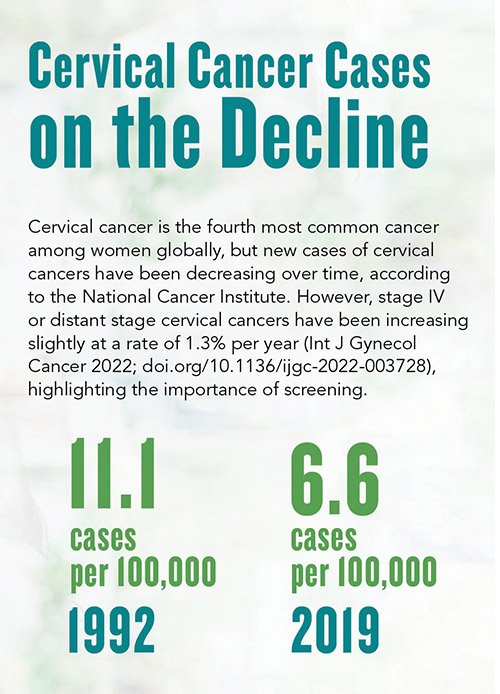
For decades, clinicians have relied on Pap tests and cytology reports to screen patients for cervical cancers. But the times are changing. More recent guidelines from groups like the American Cancer Society (ACS), American Society for Colposcopy and Cervical Pathology (ASCCP), and United States Preventative Services Task Force (USPSTF) are moving toward primary testing for human papilloma virus (HPV), which causes the majority of cervical cancers, or to cotesting using both HPV testing and cervical cytology.
To help clinical laboratories understand the nuances in this change and how it affects their work, AACC in early March released a new guidance document on cervical cancer detection that integrates previous guidelines in the context of the latest evidence on cytology, HPV assays, and more.
The authors also propose a new template for laboratorians to report HPV and cervical cancer testing results to facilitate easy interpretation of results and clinical decision-making.
“People are confused because each guideline may be a little bit different,” said Yusheng Zhu, PhD, DABCC, FADLM, lead author of the new guidance. He is a professor of pathology, lab medicine, and pharmacology, and medical director of the Clinical Chemistry and Automated Testing Laboratory at Penn State University Hershey Medical Center in Pennsylvania. “We wanted to put this together so they have a resource to compare those guidelines and select the best strategy for them for cervical cancer screening, surveillance, or diagnosis.”
MAKING SENSE OF TESTING OPTIONS
Data collected over the past 2 decades has demonstrated that primary HPV testing is more specific and can allow testing to potentially be spaced out to every 5 years, or for screening to begin at age 25 instead of 21, said guidance coauthor and gynecologic oncologist Shuk On Annie Leung, MD, an associate member of oncology at McGill University Health Centre in Montreal, Canada. This brings implications to laboratories because of the number of tests offered, how they are processed, and how results are interpreted, she said, as well as what types of reflex testing are offered: either partial or extended genotyping, and with cytology, p16/Ki-67 dual-staining.
“There are many options, so we felt there was a need for a guidance document from the laboratory standpoint that would complement the clinical guidance documents rolling out from different organizations,” Leung said.
There are three main approaches for cervical cancer screening: primary cervical HPV screening, cotesting for HPV and cervical cytology, and cytology screening alone. It’s important to parse out the language differences involved in such testing, Leung said, noting the onus is on clinicians who send the samples to specify why they are sending samples.
Screening refers to testing for individuals who are at low risk for cervical cancer and who have no prior abnormal test results. Surveillance means testing for individuals who had a prior abnormal test result that may have resulted in treatment. Diagnosis refers to testing such as colposcopy and biopsy after a patient presents with symptoms such as bleeding or discharge. The distinction is important because of the differing risk levels for patients.
IMPLEMENTING THE RIGHT SCREENING AND SURVEILLANCE STRATEGIES
HPV testing alone should not be used to screen individuals ages 21−29 because of the high prevalence of HPV in women under 30, according to USPSTF. However, ACS recommends primary HPV testing starting at age 25. Both groups note primary HPV screening should not occur at intervals shorter than 3 years, or beyond 5 years, in patients with negative screening results.
Because not all laboratories have equipment for primary HPV testing, providers may order cotesting. USPSTF recommends that co-testing be offered to patients ages 30 and older, with retesting in 5 years for those who have a negative screen, while ACS says cotesting is acceptable in people over 25.
When cervical cytology is used alone, there is an option to perform reflex HPV testing if the cytology result is positive for ASC-US. USPTSF recommends screening every 3 years with cytology alone in women ages 21-29, while ASCCP recommends that for those under 25 who have atypical squamous cells of undetermined significance (ASC-US), reflex HPV testing be performed. Screening intervals should be every 3 years, according to ACS.
There are no randomized trials comparing mortality rates among the various strategies, the authors noted, so laboratorians and clinicians can select the strategy that works best for them.
“Readers should review which assay the laboratory is currently using, and that can influence what type of testing they can do,” Leung said. In addition, the benefit of cotesting is marginal from a cost-effectiveness or screening effectiveness standpoint, which is why most clinical guideline organizations have supported primary HPV testing alone, she said.
For surveillance, ASCCP risk-based management guidelines incorporate HPV testing and cytology results with prior test results to estimate an individual’s 5-year risk of cervical cancer. Prior cytology, HPV, and pathology data are entered into a risk calculator to create a personal risk score for the patient, which helps guide clinical management. AACC recommends using this information in the ideal lab report (see next section).
The guidance offers opportunities for laboratorians and obstetrician-gynecologists to agree on what testing strategy and tests are best for their hospital or facility, said Zhu and coauthor Sarah Feldman, MD, MPH, an associate professor of obstetrics, gynecology, and reproductive biology at Harvard Medical School and a gynecologic oncologist at Brigham and Women’s Hospital and Dana-Farber Cancer Institute in Boston.
“Laboratories and clinicians will need to work together to create the infrastructure for a new paradigm for screening,” Feldman said.
DESIGNING THE IDEAL LAB REPORT
A novel section in the guidance presents a template for an ideal lab report for HPV and cervical cancer testing to help clinicians quickly review results and make decisions. The ideal report should include basic patient identifiers including name, date of birth, and medical record number, and whether the test was performed for screening, surveillance, or as a result of symptoms. There is a check box to indicate whether a patient is pregnant or immunocompromised.
The dates and results of prior testing by cytology, HPV, or histopathology should be included. In the current testing section, laboratory staff can check off if the test was cytology alone, primary HPV with reflex testing or cotesting, and what the results were, including the HPV test used and presence of HPV16 or HPV18 if positive.
In the past, testing for cervical cancer and HPV may have been handled by different laboratories, Zhu said. For example, HPV testing might have been done in the molecular lab, while cytology results were analyzed in the cytopathology lab. The result? Information was separated in electronic health records, making it difficult for clinicians to find and interpret the results.
Adding relevant information about prior cervical cancer testing to the new test results gives clinicians a more complete picture, Feldman noted: “We want the results to be super clear for interpretation. Is it positive, negative, which type of HPV, check a box sort of things so that the clinician does not have to read through long text to understand the results.”
Currently, every lab reports HPV test results differently, she said, which makes it challenging for clinicians and for aggregating data, such as running a report on all patients with HPV16 to ensure they have been followed up with appropriately.
EVIDENCE BUILDS FOR HOME TESTING
Testing strategies likely will continue to evolve, the authors noted. One potential approach is the use of self-collected vaginal specimens for genotyping of HPV that use a “dry” or lavage-based HPV sampling approach with a brush/broom. So far, this has largely been studied in other countries. Research in the Netherlands (Lancet Oncol 2019; doi: 10.1097/EBP.0000000000000837) and Mexico (Lancet 2011; doi: 10.1016/S0140-6736(11)61522-5) found that the sensitivity and specificity of HPV testing did not differ between self-sampling and clinical-based sampling, indicating that the technique could be used as a primary screening method.
Leung is incorporating this approach into her practice in Canada. “It is something that we’re moving toward, and it is very important to all of us working in cervical cancer prevention,” she said, particularly for aboriginal populations who live in remote areas up north and for immigrants who are underscreened. There are pockets of the U.S. that also have low screening rates because of geographical and cultural reasons, she said.
“Over the next decade, I do hope that self-collection will gain more in popularity and uptick, and that we will be able to move toward a Food and Drug Administration (FDA)-approved self-collection test,” Leung said.
Home testing could appeal to people who may not be comfortable with pelvic exams, including members of the LGBTQ+ communities, Feldman added. However, patients would need to come in to a healthcare facility for additional cytology testing if the HPV test result was abnormal.
Additionally, several companies are working on point-of-care devices that could allow for HPV testing at the bedside without sending samples to the central laboratory, Zhu said, which also could be helpful in low-resource settings.
Other areas to watch include automated data extraction from medical records and laboratory reports and FDA approvals for additional assays for primary HPV testing.

To access the AACC guidance document, go to www.myadlm.org/science-and-research
Karen Blum is a freelance medical/science writer in Owings Mills, Maryland. +Email: [email protected]